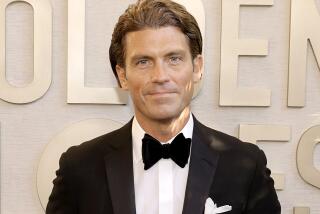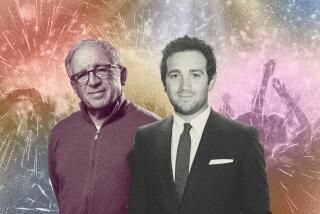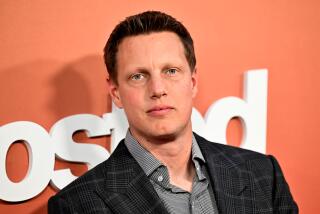David Ogilvy’s Solace: A Legend Can’t Be Sold
- Share via
He was the Babe Ruth of advertising. The legend. The home run hitter. The guy who swung for the fences with every ad campaign. He placed that famous eye patch on the rugged Hathaway Shirt man. And 30 years ago he created a form of striking--but long-winded--print advertising that is still being mimicked today.
Now, at 78, that man--David Ogilvy--is watching from afar as a stranger dabbles with his life’s work. The giant U.S. advertising agency he built, Ogilvy & Mather, finds itself the target of a hostile takeover bid by a foreign firm. WPP Group, the British company that two years ago completed a hostile takeover of the ad firm J. Walter Thompson, last week made a $725-million bid for Ogilvy Group, the ad firm’s holding company.
Most ad industry observers believe--despite the protests of Ogilvy’s top executives and David Ogilvy himself--that the agency may very well end up under WPP’s wing. But to many in the advertising industry, such a takeover would not diminish the legacy of David Ogilvy forged in the 1950s, ‘60s and ‘70s.
But to David Ogilvy at the end of the 1980s, a pressing concern right now is stopping Martin S. Sorrell, chairman of WPP, from taking control of the agency he built from scratch 40 years ago.
“I wish he’d bug off,” said Ogilvy in a telephone interview late Wednesday from his apartment in Paris. “I think of him as some cookie who is dedicating his youth to making my old age miserable.”
Although Ogilvy lives in a 12th-Century chateau about 150 miles southwest of Paris, he visited his ad agency’s Paris office on Wednesday to confer with executives about the WPP bid for Ogilvy. Although David Ogilvy retired in 1975 from his post as the ad firm’s chairman, he remains a director. Now, he is so upset about WPP’s overture for his agency that he may attend its annual board meeting May 16 in New York.
“I haven’t attended in several years, but maybe this year I’ll go,” said Ogilvy. “I started that agency without a nickel. . . . Then, this bookkeeper comes along and tries to buy the thing. Can’t he be stopped?”
If nothing else, the man who is arguably the world’s most famous living ad figure says he will do whatever he can to stop Sorrell. “Two can play at this game,” said Ogilvy. “He’s got a lot of money, I hear, but maybe there’s somebody who can buy him.”
To date, all of Sorrell’s dealings with Ogilvy & Mather have been with top management in New York. Meanwhile, David Ogilvy said he has no interest in speaking with Sorrell. “He wouldn’t listen to me,” said Ogilvy.
Besides, groused Ogilvy, Sorrell is only interested in money. “He’s a numbers guy. He’s an accountant,” Ogilvy said of WPP’s Sorrell. “Accountants are money driven. I’m not. I’d be rich if I was.”
Indeed, while Ogilvy may not be thinking about the agency’s bottom line, the Ogilvy Group on Wednesday reported record income and revenue for the first quarter of 1989. Net income was up 10.6% to $3.8 million. Revenues increased 3.5% to $198 million.
But Ogilvy will personally see little return from those numbers. At one time he owned 30% of the agency, but over the years he has sold off most of it and now owns only 25,000 shares of its stock. In a recent interview in the ad firm’s in-house magazine, Viewpoint, Ogilvy said that is one of his biggest regrets.
Stock Slips
“I was scared. We were being fantastically successful. I kept saying to myself, ‘This thing could go up in smoke at any moment,’ ” recalled Ogilvy in the interview. “But you know, every time I sold my shares, the prices of the shares went up. If I had all the shares I’d originally had, I would be worth an enormous fortune today.”
In over-the-counter trading, Ogilvy Group closed Wednesday at $49.625, off 12.50 cents. The takeover offer from WPP is $45 a share.
Those who know him best say Ogilvy has always placed his advertising over his income. “His greatest passion in life is his work,” says his son, David Ogilvy Jr., a Connecticut real estate broker. “Nothing can change that.”
Ogilvy is reknown for his punctuality, his politeness--and his stinginess with praise.
“But when he did give you praise, it would set you up for days,” said Joel Raphaelson, senior vice president at Ogilvy’s Chicago office, who has known David Ogilvy for 31 years, and who has written extensively on him. “David still remains a fastidious student of advertising.”
‘Consumer Not a Moron’
David Ogilvy liked to say that consumers should be educated and informed by advertising rather than manipulated. “The consumer is not a moron,” he told a group of advertising men. “She is your wife.”
Ogilvy’s peers still tell tales about him that seem almost unthinkable today. Bart Cummings, the 75-year-old former chairman of Compton Advertising--which is now owned by Saatchi & Saatchi--recalls one of the few times Ogilvy conceded defeat. Ogilvy was seated in a waiting room, about to pitch a client for a major piece of business. Seated across from him was the chairman of a competing ad firm. “The story goes that the fellow showed David his work right there in the waiting room,” said Cummings. “David took one look at it and told the people to hire his competition.”
Quit School
By no stretch of the imagination was advertising always in David Ogilvy’s blood. In fact, many in his family expected him to go into politics. He was born in 1911 in West Horsley, England. His father was a stockbroker and his grandfather was a merchant banker. Ogilvy was sent to Oxford to study history, but kept failing the school’s exams. Finally, he dropped out of school. Hard pressed to find a job, he moved to Paris.
Jobs for a Scotsman were few in France, so Ogilvy took a job first as a dishwasher--and later as a cook--at the Hotel Majestic in Paris. There, by chance, he met a salesman who coaxed him into peddling stoves to restaurants and hotels in England. Ogilvy proved to be a very adept salesman. But his career--and his life--began to change rapidly after he wrote a manual on how to sell stoves.
The manual was so good that Ogilvy was soon asked to work for the London ad agency Mather & Crowther. In 1937, he became an account executive and coaxed the firm to send him to the United States for some training. He resigned from the firm and became a researcher for George Gallup, the pollster. With that knowledge, nearly a decade later, he opened Ogilvy & Mather in New York at age 38.
10,000 Employees
Ogilvy & Mather grew from an agency with two employees and no clients to one with more than 10,000 workers and a client list of 3,500, including American Express, Seagram Co. and Mattel.
The agency may be best-known today for its “Membership has its privileges” print ad campaign for American Express, with photos of famous celebrities by Annie Leibovitz.
But David Ogilvy may have set the standard for all print advertising with what he called the “big idea” ad campaign he created for Rolls-Royce in the 1950s.
In the ad, a headline under a photograph of a Rolls-Royce says, “At 60 miles an hour the loudest noise in this new Rolls-Royce comes from the electric clock.” Below the headline is a 15-paragraph essay on the automobile’s features, including the fact that “a picnic table, veneered in French walnut, slides out from under the dash.”
Wish List
In 1963, Ogilvy wrote what has since become the ad industry’s Bible, “Confessions of an Advertising Man.” It is still used as a textbook at universities worldwide, and it has sold more than 1 million copies. In that book, he says he made a list of all the clients he wanted at his agency--General Foods, Lever Brothers, Bristol-Myers, Campbell Soup and Shell. He eventually got all of them, and more.
Now, all he wants is for his agency to remain independent. “I feel miserable about all this,” said Ogilvy. “I just hope someone can stop it.”
LARGEST AD AGENCIES WORLDWIDE
Ranked by 1988 worldwide gross income, figures in millions
1 Saatchi: $13,529
2 Interpublic: 8,402
3 WPP: 7,825
4 Omnicom: 7,072
5 Ogilvy: 5,703
6 Eurocom: 3,343
7 WCRS: 2,914
8 Bozell: 1,347
9 Lowe Howard-Spink: 1,316
10 GGK Holding: 578
Source: Advertising Age
More to Read
Inside the business of entertainment
The Wide Shot brings you news, analysis and insights on everything from streaming wars to production — and what it all means for the future.
You may occasionally receive promotional content from the Los Angeles Times.










